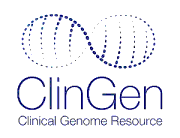Stage II: Summary Report Secondary Findings in Adults Non-diagnostic, excludes newborn screening & prenatal testing/screening Permalink Stage I Survey Update History Stage 2 Status (Adult):Complete (Actionability curation complete.)
GENE/GENE PANEL:
MEN1
Condition:
Multiple Endocrine Neoplasia Type I
Topic
Narrative Description of Evidence
Ref
1. What is the nature of the threat to health for an individual carrying a deleterious allele?
Prevalence of the Genetic Disorder
Clinical Features
(Signs / symptoms)
(Signs / symptoms)
MEN1 syndrome includes varying combinations of more than 20 endocrine and non-endocrine tumors. Associated endocrine tumors including parathyroid tumors, anterior pituitary tumors, well-differentiated endocrine tumors of the gastro-entero-pancreatic tract, carcinoid tumors, and adrenocortical tumors. Parathyroid tumors, resulting in primary hyperparathyroidism, are the most common feature of MEN1. Clinical features are related to the sites of the tumors and their products of secretion. Non-endocrine tumors include facial angiofibromas, collegenomas, lipomas, meningiomas, edendymomas, and leiomyomas.
Natural History
(Important subgroups & survival / recovery)
(Important subgroups & survival / recovery)
Parathyroid tumors, resulting in primary hyperparathyroidism, are the most common feature and the first clinical manifestation in 90% of individuals with MEN1 with onset typically between ages 20 and 25 years. However MEN1 affects all age groups, with a reported age range of 5 to 81 years. Untreated patients with MEN1 have a decreased life expectancy with a 50% probability of death by age 50. The cause of death in 50-70% of cases due to a malignant tumor process or sequelae of the disease. MEN1-associated tumors are more difficult to treat surgically, are more associated with occult metastatic disease, and may be larger, more aggressive, and more resistant to treatment than non-MEN1 associated tumors. MEN1 affects both sexes equally.
2. How effective are interventions for preventing harm?
Information on the effectiveness of the recommendations below was not provided unless otherwise stated.
Information on the effectiveness of the recommendations below was not provided unless otherwise stated.
Patient Management
Prophylactic thymectomy should be considered at the time of neck surgery for primary hyperparathyroidism in males with MEN1 syndrome, particularly those who are smokers or have relatives with thymic carcinoid.
(Tier 3)
Surveillance
Patients with MEN1 should undergo a program of combined clinical, biochemical, and radiological screening for MEN1-associated tumors. Patients are recommended to undergo screening for parathyroid tumors with an annual assessment of plasma calcium and parathyroid hormone to screen for primary hyperparathyroidism beginning at age 8. Patients are also suggested to undergo additional screening for pancreatic NET, pituitary tumors, thymic NET, bronchopulmonary NET, gastric NET, and adrenal tumors. The nature and timing of the screening will depend on local resources, clinical judgment, and patient preferences. The prognosis for MEN1 patients might be improved by presymptomatic tumor detection as earlier diagnosis and treatment of these tumors may help reduce morbidity and mortality.
(Tier 2)
Family Management
First degree relatives should be offered genetic counseling and MEN1 germline testing at the earliest opportunity given MEN1 manifestations may occur by the age of 5. In addition, genetic testing in relatives is recommended before biochemical and radiological screening tests for detection of MEN1 tumors to avoid the burden of multiple tests and reduce financial costs.
(Tier 2)
When molecular genetic testing for MEN1 is not possible or is not informative, first degree relatives of an individual with MEN1 should undergo the routine surveillance recommended for MEN1 patents.
(Tier 4)
Circumstances to Avoid
Information on circumstances to avoid was not available.
3. What is the chance that this threat will materialize?
Mode of Inheritance
Autosomal Dominant
Prevalence of Genetic Mutations
The prevalence of MEN1 is estimated at 1/30,000. Given that MEN1 mutations are detected in 80-90% of probands with familial MEN1 it is expected that the mutation frequency would also approach 1/30,000.
(Tier 3)
Penetrance
OR
Relative Risk
(Include any high risk racial or ethnic subgroups)
OR
Relative Risk
(Include any high risk racial or ethnic subgroups)
The age-related penetrance for all clinical features of MEN1 surpasses 50% by age 20 and 95% by age 40.
(Tier 3)
For specific tumor types, penetrance estimates are: parathyroid adenoma (90%), enteropancreatic tumor (30-70%), pituitary adenoma (30-40%), adrenal cortical tumor (40%), pheochromocytoma (< 1%) , bronchopulmonary NET (2%), thymic NET (2%), gastric NET (10%), lipomas (30%), angiofibromas (85%), collagenomas (70%), and meningiomas (8%).
(Tier 3)
Information on relative risk of MEN1 tumors was not available.
Expressivity
4. What is the Nature of the Intervention?
Nature of Intervention
The identified interventions involve a complex program clinical, biochemical, and radiological screenings which may be burdensome and involve risks.
5. Would the underlying risk or condition escape detection prior to harm in the settting of recommended care?
Final Consensus Scores
Outcome / Intervention Pair
Severity
Likelihood
Effectiveness
Nature of the
Intervention
Intervention
Total
Score
Score
Morbidity from parathyroid adenoma / Biochemical surveillance
1
3C
3B
3
10CB
Morbidity from other neuroendocrine tumors / Biochemical surveillance
2
3C
2B
3
10CB
Morbidity from other neuroendocrine tumors / Imaging surveillance
2
3C
2B
2
9CB
Description of sources of evidence:
Tier 1: Evidence from a systematic review, or a meta-analysis or clinical practice guideline clearly based on a systematic review.
Tier 2: Evidence from clinical practice guidelines or broad-based expert consensus with non-systematic evidence review.
Tier 3: Evidence from another source with non-systematic review of evidence with primary literature cited.
Tier 4: Evidence from another source with non-systematic review of evidence with no citations to primary data sources.
Tier 5: Evidence from a non-systematically identified source.
Date of Search:
06.04.2015
Reference List
1.
Multiple endocrine neoplasia type 1.
Orphanet encyclopedia,
http://www.orpha.net/consor/cgi-bin/OC_Exp.php?lng=en&Expert=652
2.
Multiple endocrine neoplasia type 1.
2005 Aug 31
[Updated 2015 Feb 12].
In: RA Pagon, MP Adam, HH Ardinger, et al., editors.
GeneReviews® [Internet]. Seattle (WA): University of Washington, Seattle; 1993-2024.
Available from: http://www.ncbi.nlm.nih.gov/books/NBK1538
